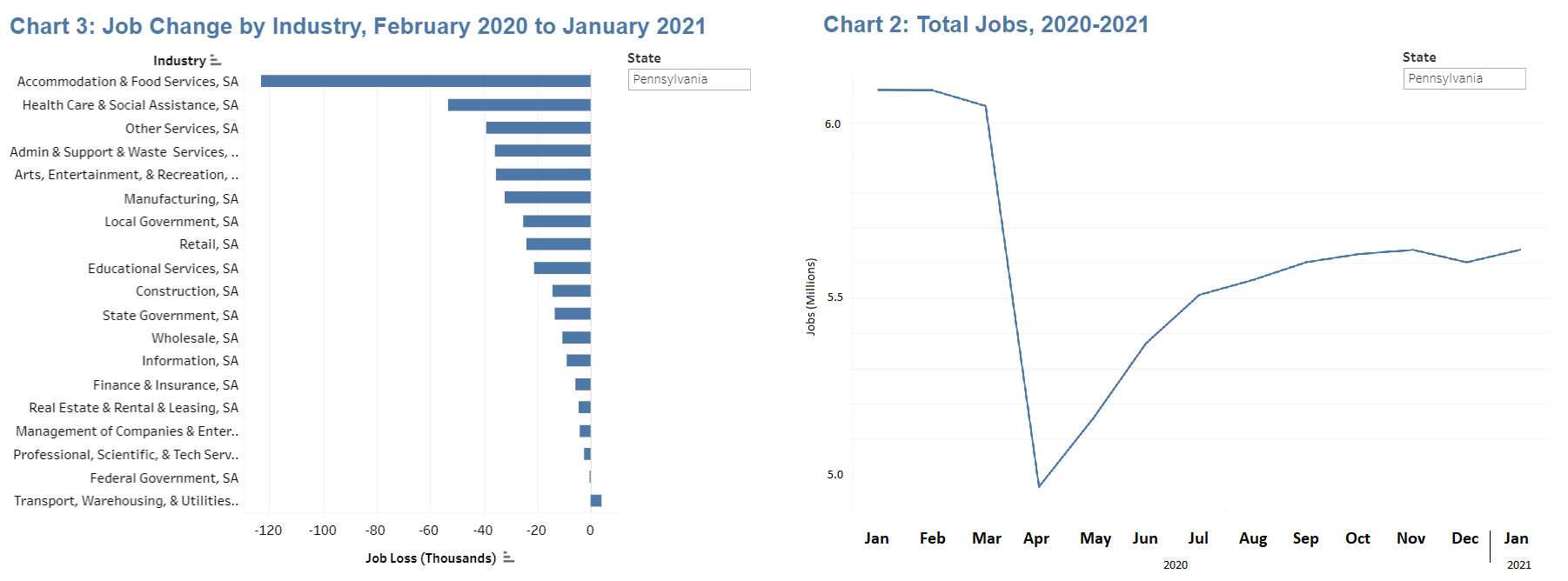
(Editor's note: This article is part of One United Lancaster's Responding to Covid series.)
In the spring of 2020, the coronavirus pandemic shook the global economy as never before.
In Lancaster County, businesses suspended operations in the wake of a statewide shutdown order intended to slow Covid-19's spread and keep hospitals from being overwhelmed. Unemployment shot up to 15.2% in April, the highest level since the Great Depression.

Statewide, gross domestic product shrank by 4.2% between the winter of 2019 and the fall of 2020. Some of the hardest-hit sectors have been those that have buoyed Lancaster County and and aided the revival of its flagship city's downtown: Tourism, hospitality, restaurants and independent retail.
Into the breach stepped the Lancaster Chamber and the Economic Development Company of Lancaster County, or EDC. The two organizations took on the ambitious task of developing and implementing a countywide economic recovery plan.
Every job saved would mean more stability for wage earners and their families. Every business saved would mean a healthier economy and a better basis from which to build a post-pandemic future.
One United Lancaster recently spoke with Heather Valudes, the chamber's vice president; and Lisa Riggs, the EDC's president. The following has been edited for clarity and length.
Valudes: The way the chamber initially reacted was to immediately start to deploy resources. Where can you find data? Where can you find information on what employers should be telling their employees right now? ...
We were doing a lot of "Ask the Attorney," "Ask the Expert," that kind of thing. We were all virtual. Everything was open to everyone who wanted to attend. They did not have to be a chamber member. Our first "Ask the Attorney" session had something like 450 people.
We were working with broad networks. We were working with the tourism network, we were woking with the nonprofit networks, to say, "Here's information. Spread it to any organization that you think would be interested, or who needs this."
Pennsylvania's shutdown distinguished between "essential" and "non-essential" businesses. If businesses felt they had been misclassified, they had to seek a waiver. Many did.
Valudes: We were getting questions like: Am I essential? Am I nonessential? How is that determined? What is my liability if my employees are on-site, even though we're considered essential?
That was all-hands-on-deck. We had a lot of organizations to connect, to figure out: Are you considered essential or nonessential? And if you're non-essential, but you believe you should be essential, how do you go through the waiver process?
Riggs: The chamber did an amazing job out of the gate. There were so many sources of information. The chamber ended up becoming a real one-stop shop; not just for things like webinars but posting material from the U.S. Chamber and other good guidance that was out there.
The EDC was thrown a total curveball, because the first relief that came out was the state offering a $60 million pot of money on a first-come, first served basis. ... We had something like 48 hours. We were literally reviewing applications over one weekend in March and trying to submit them as quickly as we could.
That was the state's Covid-19 Working Capital Access Program. The EDC was able to secure loans for 38 local businesses ranging from $27,000 to $100,000 — $3.1 million in all.
That experience, Riggs said, underscored the severity of the shutdown's economic impact, and showed how important it would be to have a solid game plan for deploying subsequent relief and creating the conditions needed for recovery.
Four core strategies for Lancaster's business recovery
- Get financial aid out the door to businesses as efficiently and quickly as possible
- Develop a plan to get businesses to a 'new normal' safely and efficiently
- Be prepared to move leading economic drivers while supporting areas of the economy that will be slower to recover
- Measure progress — to build confidence and, if needed, to course correct
Source: "Lancaster County Economic Recovery Plan," Lancaster Chamber, Lancaster EDC
Riggs: The vast majority of businesses basically lost almost a full quarter of activity. We saw some loosening up of construction in early May but basically from mid-March through early May, everything was sideways.
Valudes: A lot of businesses had upward of 90% revenue losses when you compared that quarter in 2019 to that quarter in 2020.
In May, the county commissioners made $31 million in CARES Act funds available for the Recovery Lancaster business assistance effort: $9 million for personal protective equipment and $25 million for small-business recovery grants.
Recovery Lancaster distributed PPE to hundreds of organizations, for-profit and nonprofit, and provided up-to-date guidance on retrofits, best practices for Covid-19 health and safety and so on. It distributed the small-business grants in rounds of $10 million and $15 million; the commissioners subsequently authorized another $10 million for a third round, bringing total assistance to $41 million.
Valudes: That first round, we had $10 million available, and we had $27.4 million in asks. The vast majority of them demonstrated losses. We just didn't have funding to get through even half of what they had asked for.
Riggs: You knew there was going to be more demand than what's out there, and with businesses and people who are hurting and stressed and anxious. So the best we could do is try to be as forthright as possible about how we were approaching it.
We tried to make sure we were being fair and equitable (by setting up) a transparent process, really clear criteria. We had to tweak things along the way, just because the criteria changed a little bit, but we did the best that we could.
According to Recovery Lancaster's tally, 34.2% of the grants went to women-owned businesses and 20.5% went to non-White-owned ones.
Riggs: We (understood) the significant impact on the smallest businesses in our community, on diverse-owned businesses. We ensured everything was translated into Spanish. We did outreach across the county and to almost every sector. ...
We're extremely proud of delivering $41 million in business relief and PPE kits. I'm not sure any other county did more.
Recovery Lancaster has since overseen two more grant programs: The CRIZ Covid-19 relief program and a program (for which the initial application window is closing today) focusing on the hard-hit hospitality industry.
Now, as vaccine access widens, Valudes, Riggs and their teams are looking ahead.
Valudes: One of the things we're definitely seeing at this point is some of the disparity in how to return to normal.
There are sectors that are plugging along. They've found their rhythm, they're seeing their profits return. We're seeing other sectors that, because of continued restrictions that are in place, are going to continue to be negatively impacted.
Riggs: You have this segment of our population, maybe it's 10%, maybe it's 15%, that's very hard-hit. But the rest, everyone else, is gangbusters. It's a real "Tale of Two Cities." ...
Part of what happens in the next nine to 12 months is, how do we provide support to these businesses, especially small businesses, across the hospitality industry, some sectors of manufacturing, who have been dealing with this uncertainty and challenge, and get them to be on the upswing as we get through vaccination? ...
Valudes: Even for people that are still in the hardest-hit sectors, there's an optimism that it's going to get better. There's just an immediacy issue for some sectors and some businesses.
Riggs: Based on where we are today, there's clearly a renewed sense of hope and optimism. Later this spring and into the summer, we're hopefully seeing a return to more normal conditions. ... Overall, people feel like there's light at the end of the tunnel.






